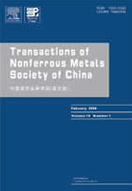Calcium titanate corrosion inhibitor enabling carbon as inert anode for oxygen evolution in molten chlorides
(1. School of Resource and Environmental Sciences, Wuhan University, Wuhan 430072, China;
2. Hubei International Scientific and Technological Cooperation Base of Sustainable Resources and Energy, Wuhan 430072, China)
2. Hubei International Scientific and Technological Cooperation Base of Sustainable Resources and Energy, Wuhan 430072, China)
Abstract: The corrosion inhibition efficacy of titanate (CaTiO3) for carbon anodes in molten salts was investigated through various analytical techniques, including linear sweep voltammetry, X-ray diffraction, scanning electron microscopy, and energy dispersion spectroscopy. The results demonstrate that the addition of CaTiO3 corrosion inhibitor efficiently passivates the carbon anode and leads to the formation of a dense CaTiO3 layer during the electrolysis process in molten CaCl2-CaO. Subsequently, the passivated carbon anode effectively undergoes the oxygen evolution reaction, with an optimal current density for passivation identified at 400 mA/cm2. Comprehensive investigations, including CaTiO3 solubility tests in molten CaCl2-CaO and numerical modeling of the stability of complex ionic structures, provide compelling evidence supporting “complexation-precipitation” passivation mechanism. This mechanism involves the initial formation of a complex containing TiO2·nCaO by CaTiO3 and CaO, which subsequently decomposes to yield CaTiO3, firmly coating the surface of the carbon anode. In practical applications, the integration of CaTiO3 corrosion inhibitor with the carbon anode leads to the successful preparation of the FeCoNiCrMn high-entropy alloy without carbon contamination in the molten CaCl2-CaO.
Key words: corrosion inhibitor; calcium titanate; carbon anode; oxygen evolution reaction

